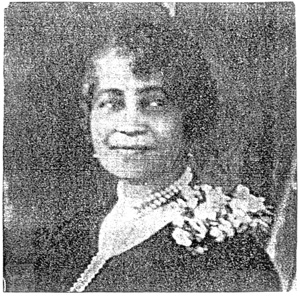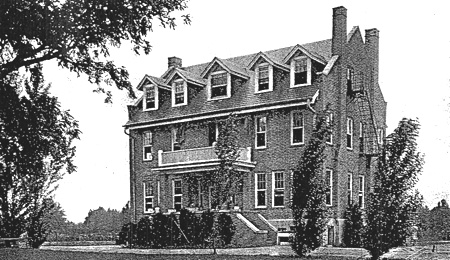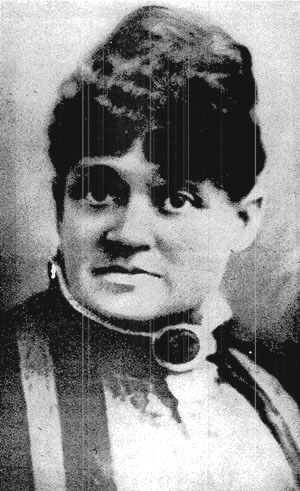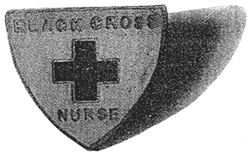HISTORICAL PERSPECTIVES ON SOCIAL WELFARE IN THE BLACK COMMUNITY (1886-1939)
A Graduate and Undergraduate Teaching Aid
Wilma Peebles-Wilkins, PhD
wpeebles@bu.edu
Sponsored by Boston University and the John Hope Franklin Center for Interdisciplinary and International Studies at Duke University
|
|
“… Janie Porter was urged by her benefactor to go to theNorth for College and prepare to pass into white society. Had she done so we might now see her name along with Lillian Wald, Jane Addams, and Mary McDowell as founders of the American settlement movement.”
|
Janie Porter Barrett, Founder, Locust Street Settlement (1890), first in Black Community |
|
Conceptual Framework | Helpful Definitions | The Child Welfare Example |The Presence of Social Work Values | Community Feminism, Globalism, and Health Care Disparities | Photo Credits | Special Collections and Clipping Files | Documentation and Suggested Readings | Links
Conceptual Framework
Over the past two decades, social work educators and students have developed a body of literature, which describes the legacy, and contributions of African Americans or members of the Black community to social welfare historical developments. Prior to this time, the social welfare/social work history literature was limited most often to discussions about slavery and the Freedman’s Bureau, the Niagara Movement and the development of the NAACP, and periodically inclusion of content on the Urban League, and sometimes timeline information on the development of some of the earlier Historically Black Institutions such as Fisk University. Little content, if any, was available on the pre-Civil War or Civil War period. Rarely did lectures about social settlements include social settlements in the Black community, such as the Locust Street Settlement in Hampton, Virginia founded by Janie Porter Barrett. Barrett remained in the shadow of Jane Addams, Lillian Wald and other white women pioneers in the northeast.
Some social policy educators have indicated that African American or Black social welfare activities were residual in nature, were not mainstream activities, and therefore should not be considered social welfare activities. In this way of thinking, social welfare history should primarily describe the development of institutionalized and universal services. This perspective leads to a historical presentation of social welfare based on temporary activities which became permanent, which are primarily public and governmental, and which tend to exclude the earlier private social welfare activities which transpired historically in the segregated Black community through voluntary associations or mutual aid organizations. The reality is that there are examples of both public and private social welfare activities, which transpired under segregation customs, which have persisted over time and have not been included in the study or presentation of social welfare history. Excluding this content does not help social work students fully understand how Black people were cared for during historical times when they were totally excluded from the so-called mainstream or universal service delivery system. Definitions are helpful in responding to issues of residual (temporary) versus institutional (enduring) social welfare activities. Definitions are also helpful in developing a framework for integrating historical content on social welfare provisions in the Black community into the social work foundation curriculum.
Helpful Definitions
- Mutual aid – is a social welfare arrangement or form of group support in which individuals with a common concern, a shared heritage, culture or sense of community bond together for the purposes of care giving and meeting each other’s needs. Dating back to at least medieval times, mutual aid activities range from informal helping networks to formally organized voluntary associations.
- Voluntary association - a formally organized social group or private, non-governmental common interest organization that tends to be more formal and viewed anthropologically as an adaptive or survival mechanism. A social agency under church auspices, for example, could be considered a voluntary association, or formally organized social group.
- Selective social service provisions – social services which are geared toward a special ethnic or racial group, specified community catchment or geographical area. This form of social service delivery was very prevalent in inner city neighborhoods during the 1960’s under governmental as well as voluntary sponsorship.
- Universal social service provisions- social services that are for ‘all’ and are not limited to a specified geographical area, or designated group of individuals.
Social welfare in the United States and North America evolved from both public and private services which were residual or temporary in nature. Most social welfare policy experts take the position that prior to 1932 and the establishment of ‘safety net’ oriented governmentally sponsored programs, social welfare services were residual. Historically, even residual services were provided under segregation customs in most communities. For example, during the Colonial Period in this country, Black slaves were cared for on plantations, free blacks developed group support mechanisms, and as a rule of thumb all Black people were excluded from care under early Poor Law provisions. To fully understand the historical delivery of social services to African Americans or members of the Black community, one needs to take into account that in the early development of social welfare services, African Americans were cared for in separate historical spheres or excluded from governmental provisions under segregation customs. It is important for social work students to understand this duality and recognize that the early development of social welfare services transpired under parallel systems. This knowledge provides a context for understanding and appreciating the African American and/or Black experience in the United States and North America.
 |
“… social welfare systems do not arise in a vacuum; they stem from the customs, statutes, and practices of the past. Therefore, one cannot understand current efforts to help the needy without first comprehending the foundations on which they were built.”
|
Fredericka Douglass Sprague Perry, Founder, Colored Big Sister Home for Girls (1934), Kansas City, Missouri |
|
The Child Welfare Example
Well into the 1960's, because of racial segregation, in many communities, dependent children of color were placed in adult jails. To prevent such harsh treatment, African American social reformers such as Janie Porter Barrett, Fredericka Douglass Sprague Perry, and Carrie Steele worked to create alternative services. Steele worked as an individual to rescue abandoned children. Barrett and Perry worked through the African American women's clubs movement to establish the first juvenile facilities for African American adolescent girls in their respective communities. Their activities led to more inclusive mainstream home finding and child placement provisions for African American children..
Such women are rarely included in the social work curriculum components describing social welfare historical developments but need to be included to teach all students how people of color were cared for in segregated communities. This approach also provides students with vital information about identity, resiliency, and methods used for coping with exclusion and discrimination. Rather than see African Americans as always victims, students learn to appreciate mutual aid, self-help and other activities within the Black community that helped African Americans overcome victimization and respond to unmet human need. (See classic work by Andrew Billingsley and Jeanne Giovanni, Ch.3.)
The Presence of Social Work Values
Janie Porter Barrett
|
|
"At that time, there was no place but the jail for a colored girl…”
|
Federation Cottage (Honor Cottage) of Virginia Industrial School |
|
Janie Porter Barrett, who founded the Locust Street Settlement in 1890 in Hampton, Virginia, modeled her settlement house after Hull House founded the year before by Jane Addams. The Locust Street Settlement was operated out of the home until 1902 when a separate physical facility was built. Among other activities, Barrett initiated child placement activities from Locust Street. She later continued her child saving interests outside of Richmond, Virginia where, with the help of The Virginia State Federation of Colored Women’s Clubs, she founded the Virginia Industrial School for Colored Girls in 1915. Barrett’s approach to social reform also included interracial cooperation. White social reformers such as Jane Addams, who, in 1911, gave a Chicago tea party at Hull House in Barrett’s honor, recognized her work.
The Virginia Industrial School for Colored Girls, which exists today as the Barrett Learning Center became a model for other states. Before officially opening the training facility, Barrett used consultation from Dr. Hastings Hart of the Russell Sage Foundation. Without a doubt, she established a standard of care for dependent Black children who had heretofore been treated poorly. At her home school, as it was called, Barrett created a growth promoting atmosphere for young Black girls. The child welfare and educational principles used to foster the growth and development of the dependent girls in her care were adapted from the Child Welfare Department of the Russell Sage Foundation, now the Child Welfare League of America. Her expressed philosophy is akin to contemporary social work values. A comparative chart follows.
| EXPRESSED PHILOSOPHY/EDUCATIONAL THEORY |
SOCIAL WORK VALUE/PRINCIPLE |
|
Kindness rather than severity. |
Non-judgmental/non-punitive |
|
Give her every chance to make good, leaving mistakes behind. |
Acceptance, basic worth and dignity |
|
I have an open forum as often as the girls want it, where a girl can say anything she has on her mind |
Purposeful expression of feelings |
|
The white people and black people are working together to liberate the lowliest girls in our Commonwealth from ignorance, prejudice, hatred, vice... |
Improving quality of life, realization of goals and aspirations |
|
...teaching them the lessons of love of race, love of fellow-man, love of country. |
Democratic/caring social order |
|
We are trying hard to live by the Golden Rule. |
Justice and fairness |
|
Accomplishment through faith, goodwill, cooperation. |
Harmony, group cooperation |
Fredericka Douglass Sprague Perry
Fredericka Douglass Sprague Perry, the granddaughter of Frederick Douglass called attention to the need for home finding services for African American children in Kansas City, Missouri during the mid-1930. At the time, home finding for only needy white children in Kansas City was conducted by the local Community Charities Chest Committee. Dependent African American children age 12 years and older were routinely sent to a state delinquency institution until age 17. Fredericka Perry had been a juvenile court worker and was very concerned about curtailing delinquency. Through the organized activities of the Kansas City Federation of Colored Women’s Club, Mrs. Perry founded the Colored Big Sister Association of Kansas City. The Association operated the Colored Big Sister Home for Girls to conduct home finding activities and to prevent placement of dependent African American girls in the state institution for delinquents. Mrs. Perry served as superintendent for the resident and with interracial cooperation; the home existed until July, 1943. While undocumented, it is likely that these activities were absorbed by mainstream child welfare services.
Carrie Steele
|
|
“…child welfare for Black children in the Twentieth Century…shift [ed] from total exclusion to partial inclusion.”
|
Carrie Steele founded an orphan home in Atlanta in 1888. |
|
Carrie Steele’s well-known orphan home founded in 1888 still exists today in Atlanta, Georgia as the Carrie Steele-Pitts Group Home. This United Way funded modern day child care agency is a private, nonprofit organization serving children 6-18 years of age in a cottage atmosphere. The agency is approved as a state care provider and offers counseling, tutoring, as well as services to developmentally disabled and sexually aggressive children. Today, not only are orphaned or abandoned children served, but children in the child welfare categories of neglected or abused are also provided services. Mrs. Steele was a terminal maid for a railroad station where children and babies were being abandoned. She began rescuing these children, caring for them in a railroad boxcar by day and in her home at night. The sale of her own home and her community fundraising efforts on behalf of these children resulted in a state-chartered non-profit organization which became institutionalized. A century later, 1988, there were five cottages, a central dining facility, and an administration building on seventeen acres of land. Today, there is a cultural learning center and more.
Community Feminism, Globalism, and Health Care Disparities
|
|
“The aftermath of the fury-driven hurricane which struck Belize City on September 10, 1931 summoned the Black Cross Nurses and their trainees to emergency service.”
|
Black Cross Nurses Association official emblem, Black Latin Cross encircled by a Red background in the center of a Green Field worn on a Nurse's Cap |
|
Community activism among Black women was prevalent during the Progressive Era through individual activism and the national and state level organization of Black Women’s Clubs. The Black Women’s Club Movement focused on social problems in the African American community and tended to be geared toward responding to the unmet needs of families and children. A special emphasis was placed on the growth and development of young girls. The ‘womanist consciousness’ (Black feminism) that formed the social ethic of these middle and upper class Black women activists can be considered a form of community feminism. These women activists were sometimes referred to as Race Women or Race Mothers. The womanist philosophy focused on racial uplift (“Lifting as We Climb”) or improving living conditions in the Black community and supporting Black men to assume the traditionally established male roles. Elements of such community feminism can also be found in the activities of the women associated with the Universal Negro Improvement Association (UNIA), a Pan-African movement founded in Jamaica in 1914 by the politically controversial historical figure, Marcus Garvey. Based on his humanitarian concerns, Marcus Garvey intended for this voluntary association to respond globally to the health and social care needs in the African Diaspora. During the early 1920’s, there was a membership of about six million people and hundreds of branches throughout the United States and other parts of the world.
In 1920, Garvey formed the Black Cross Nurses’ Association as an auxiliary of the UNIA. The Black Cross Nurses Association was modeled after the American Red Cross, an organization that denied admission to these Black nurses. The Black Cross Nurses Association was an enduring legacy of the UNIA and the Garvey movement well into the 1980’s in the country of Belize in Central America. During the early decades of the twentieth century, there was universal concern about sanitary and health conditions in crowded urban communities as well as rural areas. Health care disparities were pronounced in the African American community where disproportionate numbers of people became stricken with diseases such as tuberculosis. There were higher infant mortality rates and more problems with poor nutrition. The Black Cross Nurses Association was committed to community health education and improving the health conditions and standards in the Black Community. In the United States, among other activities, the Black Cross Nurses organized soup kitchens and helped the homeless. The association also responded to the needs of Black people during times of disasters such as floods. In 1921 for example, Black Cross Nurses in Cleveland, Ohio were reported to have fed over 6,000 unemployed African American men and women. In Belize, the association focused on community hygiene, child welfare, family and infant health care. Well into the 1980’s Belizean Black Cross Nurses supplemented the work of governmentally sponsored health clinics. Significant contributions were made to maternal and child health care in Belize.
Note on Chronology: The historical timeframe herein begins with the opening of Neighborhood Guild, the first social settlement founded in 1886 by Stanton Coit. The timeframe ends with passage of the 1939 amendments to the Social Security Act and expanded governmental support for those in need.
Photo Credits
Photo of Janie Porter Barrett is from The Virginia Industrial School. (1923), The Southern Workman, August, 52, p.399. Peabody Collection, Hampton University, Hampton , Virginia.
Photo of Fredericka Douglass Sprague Perry is from Perry, J.E. (1947). Forty cords of wood. Jefferson City, Missouri: Lincoln University, p.319.
Photo of Federation Cottage is from Twenty Fourth Annual Report of the Virginia Industrial School for Colored Girls. (1939). Peake (Hanover County ), Virginia , p.2. Virginia State Library, Richmond, Virginia.
Photo of Carrie Steele is from 100 years, 1888-1988, Carrie Steele-Pitts Home, Inc., share the legacy, Atlanta, Georgia. (Anniversary fundraising brochure).
Photo of Black Cross Nurses emblem is from Origins of Tomorrow cited in the readings list.
Special Collections and Clipping Files
Primary source documentation can be found among the reference list of articles which were used to support website content. However, individuals interested in further historical research on Janie Porter Barrett or Fredericka Douglass Sprague Perry may wish to consult the supplementary list of special collections and clipping files below:
- Clipping Files, Missouri Valley Room, Kansas City Public Library, Kansas City, Missouri.
- Clipping (Peabody) Files Box 28, Huntington Memorial Library, Hampton University, Hampton, Virginia.
- Frederick Douglass Papers, Moorland Spingarn Research Center, Howard University, Washington, D.C.
- Inman E. Page Library, Lincoln University, Jefferson City Missouri.
- Mary Church Terrell Papers, Moorland Spingarn Research Center, Howard University, Washington, D.C.
- Peabody Collection, Hampton University, Hampton, Virginia.
Documentation and Suggested Readings
Barrett, J.P. (1926). The Virginia Industrial School. Southern Workman, 55, 353-361. Hampton, Virginia: Peabody Collection, Hampton University.
Berlin, S. B. (2005). The value of acceptance in social work direct practice: A historical and contemporary view. Social Services Review, September, 79(13), 482-511.
Billingsley, A. and Giovannoni, J. (1972). Children of the storm. New York: Harcourt Brace Jovanovich, Inc., Ch.3.
Brown, E.B. (1990). Womanist consciousness: Maggie Lena Walker and the Independent Order of Saint Luke in Ellen Carol Dubois and Vicki L. Ruiz (EDS.), Unequal sisters: A multicultural reader in U.S. women’s history, (pp.208-223).New York: Routledge, Chapman and Hall, Inc.
Carlton-LaNey, I. (1999). Early African American social work pioneer’s response to need. Social Work, 44(4), 311-321.
Chandler, S.C. (2005). Addie Hunton and the Construction of an African American Female Peace Perspective, Affilia, fall, Vol.20, No.3, 270-283.
Educational Policy and Accreditation Standards. (2008). Alexandria, Virginia: Council on Social Work Education, Commission on Accreditation.
Edwards, R. L. (Ed.). (1995). Encyclopedia of Social Work, Nineteenth Edition, 3. Washington, D.C.: National Association of Social Workers. (See Bibliographies).
Gordon, Linda. (1991). Black and white visions of welfare: Women’s welfare activism, 1890-1915. Journal of American History, 78, 559-590.
Griffith, Mignon. (1985). Black Cross Nurses Assoc. (BCNA), CVSS Connection, December, 5. Belize, Central America: Council on Voluntary Social Services.
Hermann, Eleanor Krohn. (1985). Origins of tomorrow: A history of Belizean nursing education. Belize: Ministry of Health.
Herrick, J.M. and Stuart, P.H. (2005). Encyclopedia of Social Welfare History in North America. Thousand Oaks, CA. Sage Publication, Inc.
Hill, Robert A. (Ed.). (1983). The Marcus Garvey and Universal Negro Improvement Association Papers , II and III. Berkeley : University of California Press.
McPherson, Anne. (2003). Colonial matriarchs: Garveyism, maternalism, and Belize’s Black Cross Nurses, 1920-1952. Gender and History, November,15(3),507-527.
New Georgia Encyclopedia: Carrie Steele Logan (1829-1900). Retrieved August 11, 2023 from https://www.georgiaencyclopedia.org/articles/history-archaeology/carrie-steele-logan-1829-1900/.
Peebles-Wilkins, W. (1995). Janie Porter Barrett and the Virginia Industrial School for Colored Girls: Community response to the needs of African American children. Child Welfare, January/February, LXXIV (1), 143-161.
________________. (1994). Effectively teaching African American social welfare historical developments, Journal of Sociology and Social Welfare, March, XXI (1), 139-152.
________________. (1990). Black women and American social welfare: The life of Fredericka Douglass Sprague Perry. In Black Women in American History: The twentieth century. Darlene Clark Hine (Ed.). New York: Carlson Publishing, Inc., 8, 979-990.
Reif, Michelle. (2004). Thinking logically, acting globally: The international agenda of African American clubwomen, 1880-1940, Journal of African American History, 89(3), 203-222.
Scott, A. F. (1992). Janie Porter Barrett. In D.C. Hines (Ed.), Black women in America: An historical encyclopedia, (pp.90-92). New York: Carlson Publishing Company.
Taylor, U.Y. (2000). “Negro women are great thinkers as well as doers”: Amy Jacques-Garvey and community feminism in the United States, 1924-1927, Journal of Women’s History,summer, 12(2), 104-123.
Trattner, W. (1986). Biographical dictionary of social welfare in America. New York: Greenwood Press.
________. (1999). From poor law to welfares state, 6th edition. New York: The Free Press.
Wilensky, H. and Lebeaux, C. (1958).Industrial society and social welfare. New York: Free Press. See classic conceptualization of residual vs. institutional social welfare.
Links
- Social Welfare History Project
- Boston University
- The John Hope Franklin Center for Interdisciplinary and International Studies at Duke University



